
EVADE
OmniVeil
OmniVeil Camouflage
Background on Traditional hunting camouflage
To the modern hunter, there is an overwhelming level of choice when it comes to hunting camouflage systems and designs. Most of the hunting camouflage patterns available today can loosely be separated into two categories; abstract and mimetic. To date the vast majority on offer by hunting apparel manufactures utilise the mimetic style, that is, these patterns are designed to mimic their surroundings. They are intended to disguise hunters within a specific habitat by blending them in amongst the natural setting. Most of these camouflages patterns will utilise elements from within the target environment such as branches, leaves, grass, sticks, etc. These photorealistic patterns can perform well at blending a hunter into their intended habitat; usually this will be timbered forest country owing to the assortment of picture like foliage within the design, but these can also range into grassland, wetlands, dense forest, etc. However, some of these patterns can often be less effective when removed from the target scene they are meant to mimic.
As distances increase, many mimetic designed camouflage patterns have a tendency to lose their fine photorealistic detail, while also falling into a state of isoluminant equilibrium. In this condition, the designs individual component colors, tone and texture become so equated that they visually take on the form of a solid color and luminance. Many hunters refer to this melding of tone and color as “blobbing out”. This phenomenon has the potential to expose the human outline to game animals in the form of a dark silhouette at medium to longer distances.
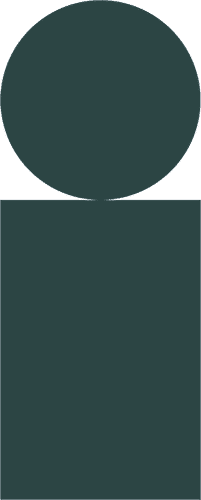
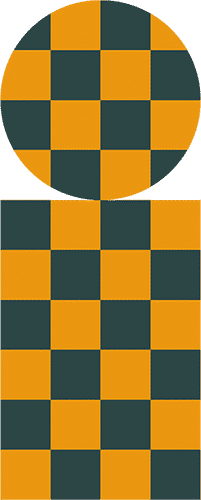
This simple example illustrates the working principle behind the macro pattern concept. In this demonstration we use basic geometric shapes comprising of circles, squares and rectangles. Note how the first object is easily recognisable as a circle and rectangle. While the second object creates visual confusion, giving the illusion of many small squares rather than a whole object.
Although less common, the other camouflage styles available that are still popular with a great deal of hunters are the patterns that have been created using an abstract design. These styles will often incorporate moderate to sizably proportional geometric or vector based shapes with contrasting color schemes. As many of these patterns generally do not contain tonal gradients or texture, they tend to lack the finer details associated with the mimetic styles. At close distances, the lack of texture makes many of these patterns less effective to express the finer details common to mimetic styled camouflage. However, as ranges increase (and this is also greatly dependant on the design, tonal luminance and spatial frequency employed) some of these abstract designs have the ability to disrupt the boundary recognition of a human silhouette through application of large contrasting pattern shape elements, often referred to as a macro pattern.
These abstract designed camouflage systems are not necessarily always created to blend or hide the hunter into their surroundings, but rather they are designed to deceive game animals into believing that what they are in fact looking at is not actually a threat. A single solid colored object can be readily recognisable, while a two toned object has the ability to create visual confusion. The contrasting borders between tonal groups can be perceived as natural boundaries. As such, game animals can be deceived into thinking they are looking at a clump of shapes, rather than a single solid mass.
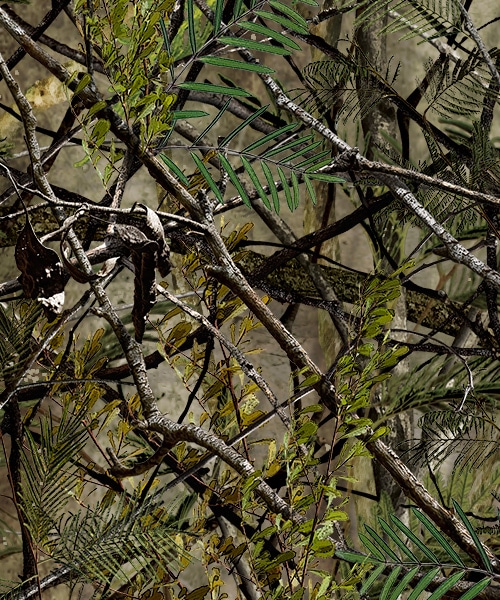
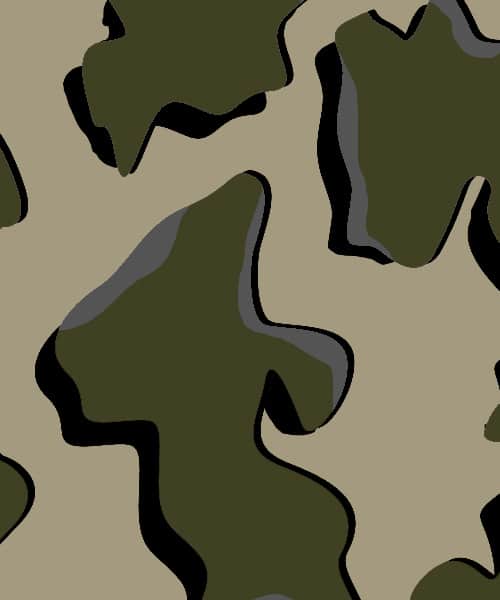
The first image represents a typical mimetic camouflage pattern design, while the second demonstrates a simple abstract pattern design. Note the intricate detail within the mimetic camouflage that help this style blend in well at close distances, while the abstract pattern looks much less natural up close.
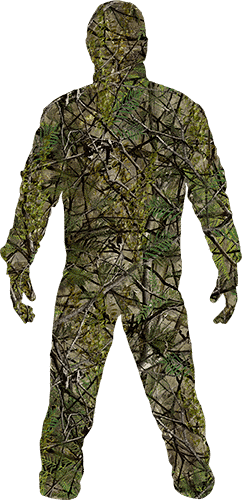
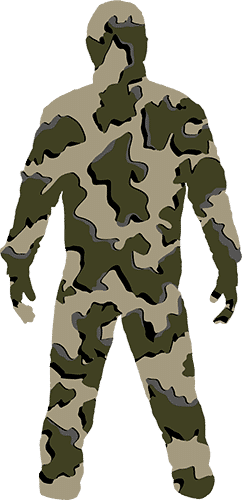
However, as we zoom out to represent longer distance the mimetic pattern is already beginning to isoluminate (blob out), while the abstract design demonstrates macro pattern boundary disruption (break up silhouette).

Camo that just works
The development of OmniVeil has been an ongoing process that has taken many years to achieve. There have been in excess of 60 versions created with over 20 costumes constructed to gauge environmental effectiveness. During the development phase we have created both pure mimetic, pure abstract and combination designs. All of our early patterns were created utilising mimetic paradigms, this proved to be constraining due to the simple fact that elements in the natural world follow certain basic rules. For example trees grow upwards, hanging leaves point downward, the sun casts shadows from above, etc. In keeping with this protocol, difficulty was experienced when trying to create a camouflage system that was capable to perform certain concealment objectives, while also attempting to make it look “natural”.
Doing away with old concepts
In creating Evade OmniVeil, our goal was to develop a total concealment camouflage solution for stalking hunters. A general-purpose multi terrain design that would benefit mobile hunters; who can often find themselves moving into different and varied surroundings during the course of a hunting day. We did not wish to link it to any specific habitat, thus also extending its versatility. From the outset it was our goal to develop a dual performance camouflage system, a concealment solution that could perform twin tasks. Blending capability to benefit hunters waiting in ambush, or within close vicinity hunting encounters. While also incorporating the ability to boundary disrupt the contour lines of a human silhouette to assist with none threat deception while stalking game.
In order to attempt achievement of these difficult objectives, we returned to the drawing board and began creating camouflage patterns from the ground up. Analysing some of our earlier designs and adopting their benefits, while also searching for insight. We soon realised that the use of photorealistic natural elements were not necessarily required to blend a pattern into natural bush like surroundings, as this could also be achieved in other ways. This insight created greater opportunity of a higher scope, for we were no longer constrained to follow certain natural looking lines. Liberated from this constraint, it would allow for the creation of a design that we could actually tailor to achieve our desired goals, rather than appear to look like a picture scene from a bush setting.
At its core Evade OmniVeil utilises an abstract designed concealment solution that has been built off an earth tone color palette, comprising of both dominant and accent pantones. It has been constructed to incorporate fine detail; thus providing blending capability at close hunting distances. These details appear as random tonal microstructures of varying size and scattered distribution. Although appearing random in nature, these pattern elements have been carefully placement mapped in order to achieve specific performance results. Each series comprises of a solid pantone; as such Evade OmniVeil does not contain any color or tonal gradients. Unlike many vector based abstract hunting patterns, we do not use smooth sharp lines to separate pattern colors. Evade OmniVeil incorporates scattered, unstructured, random sized dithering to achieve transitional separation, thus avoiding high contrast smooth lines; which can at times appear unnatural at close hunting distances.
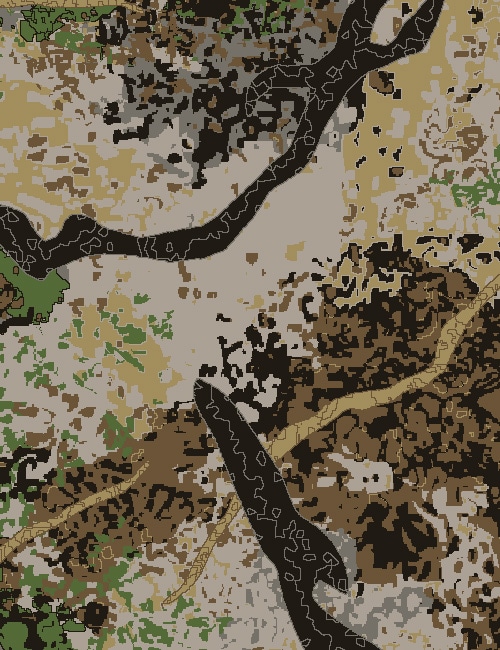
Color partition is achieved through scattered, unstructured, random sized dithering to create transitional separation and a more organic, natural appearance.
These colored pattern microstructures have been matched with similar neighbouring random elements of specific color, tone and contrast. In this manner tonal clusters of irregularly shaped and colored canvas pattern elements are constructed, which creates an illusion of earth texture for increased blending capability. As distance increases, these tonal clusters have been structured to create two distinctive tonal groups, dim and pale. In order to understand the benefits of this, we need to revisit one the main drawbacks of mimetic camouflage, isoluminance. The melding of tone and color as distance increases to create the illusion of a single solid color.
Macro Pattern
We have created Evade OmniVeil to take advantage of the isoluminance phenomenon. As distance increases, the tonal and pantone pattern microstructure textures within the design that form dual tonal groups, dim and pale, are “intended” to isoluminate. In this manner we create a twin-toned boundary disrupting macro pattern at medium to longer ranges, while still retaining blending textures for close vicinity concealment.
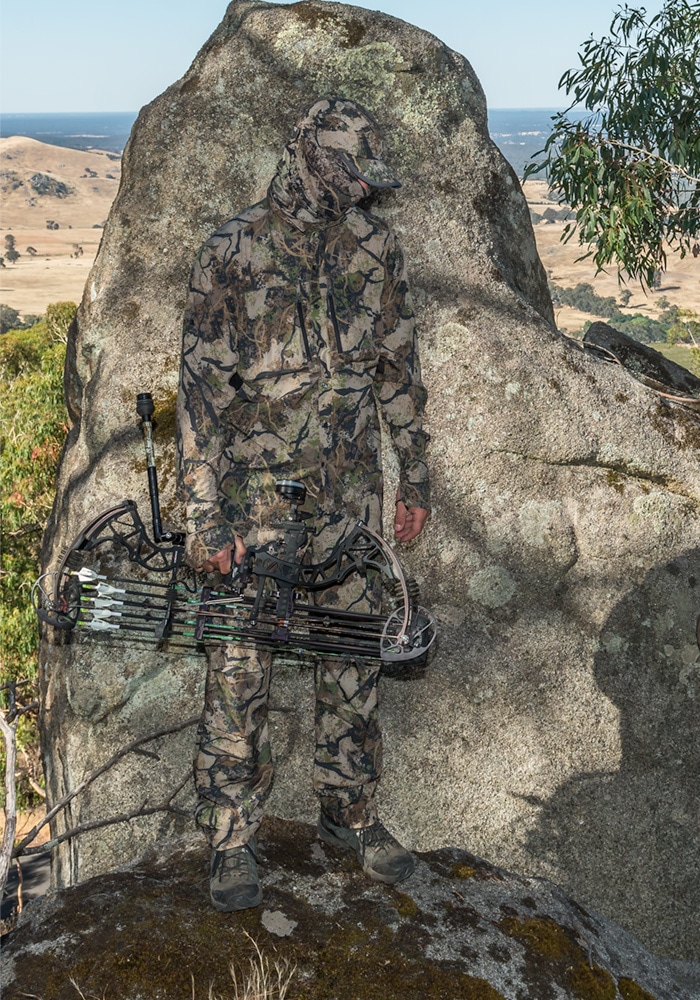
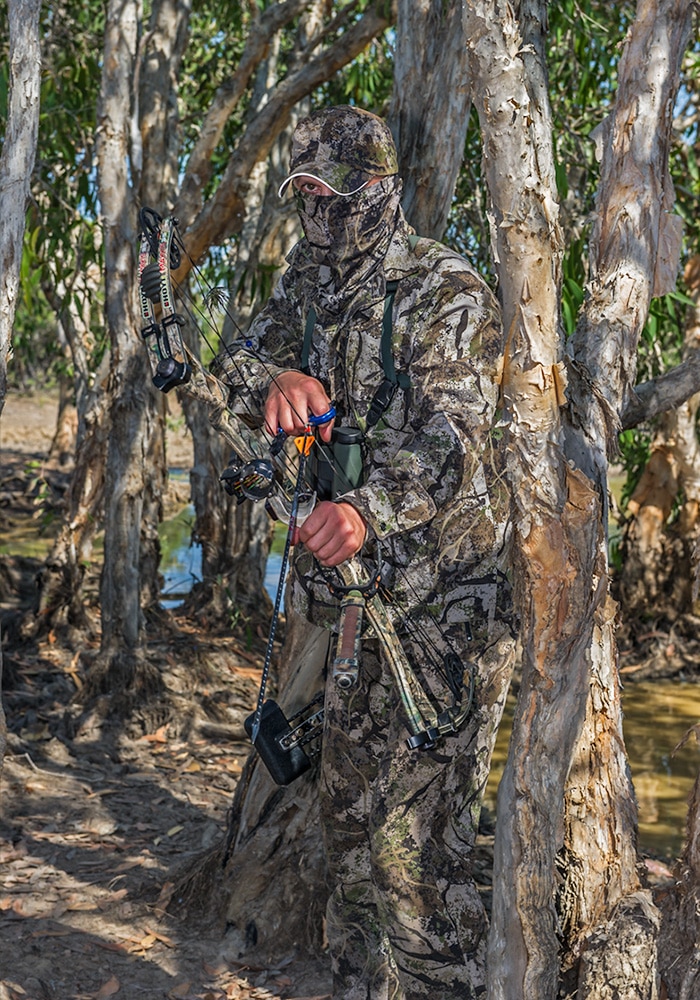


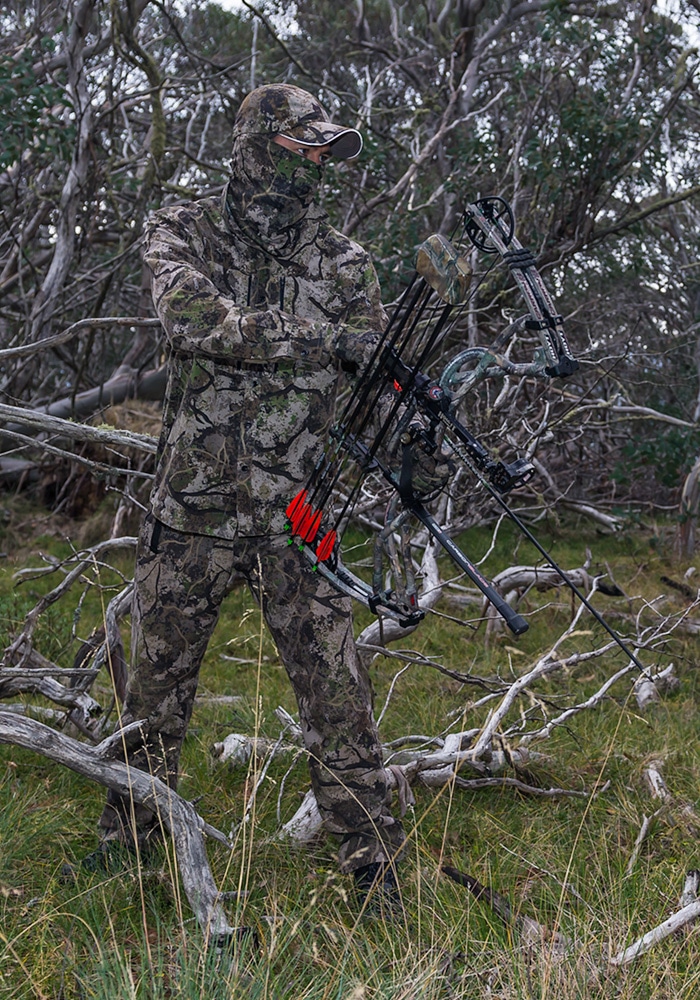
During development and testing, we experimented with differing scaled macro pattern proportions, assessing performance over various but typical hunting distances. With Evade OmniVeil we have incorporated a medium to large scaled macro pattern with near optically equal spatial distribution, we found this scale provided the best all round boundary disrupting effect. However, we did feel that this generated a somewhat open pattern design for near vicinity concealment.
To assist with visual close distance macro pattern disruption, alternate toned stripes were overlayed onto the design. We experimented with various shapes to achieve the overall desired objective including both geometric and natural; finally inspiration came from one of the world’s most lethal predators boundary disrupting concealment advantages, the high contrast macro pattern stripes of the Asiatic jungle tiger. In keeping with the random motif of the camouflage design, the scaled down alternate toned predator stripes have been carefully placement mapped in a visually random and unorderly manner. In doing so we add another layer of concealment to the design in the form of enhanced pattern disruption.
Creating multi terrain camouflage solutions does present certain difficulties. We have long realised that the ability to blend into every conceivable natural environmental setting with a single camouflage design is unachievable if not impossible. The variables are just too great. For example, patterns that perform well in a dimly lit low contrast rainforest habitat would not be expected to perform very well in open brightly lit grassland or desert environments, with the opposite also to be expected.
To tackle this difficulty, Evade OmniVeil has been created to blend into varied habitats, the use of random tonal pattern microstructures and disruption elements do not link it to any specific background, allowing for adaptation into multiple environments. Should a scenario arise whereby the ability of the camouflage system to blend into its surroundings is compromised, it utilizes the boundary disrupting fall-back design feature to then break up the human outline through the macro pattern principle. Thus still providing a degree of concealment in the form of boundary disruption, even if it is incapable to completely blend into its surroundings.
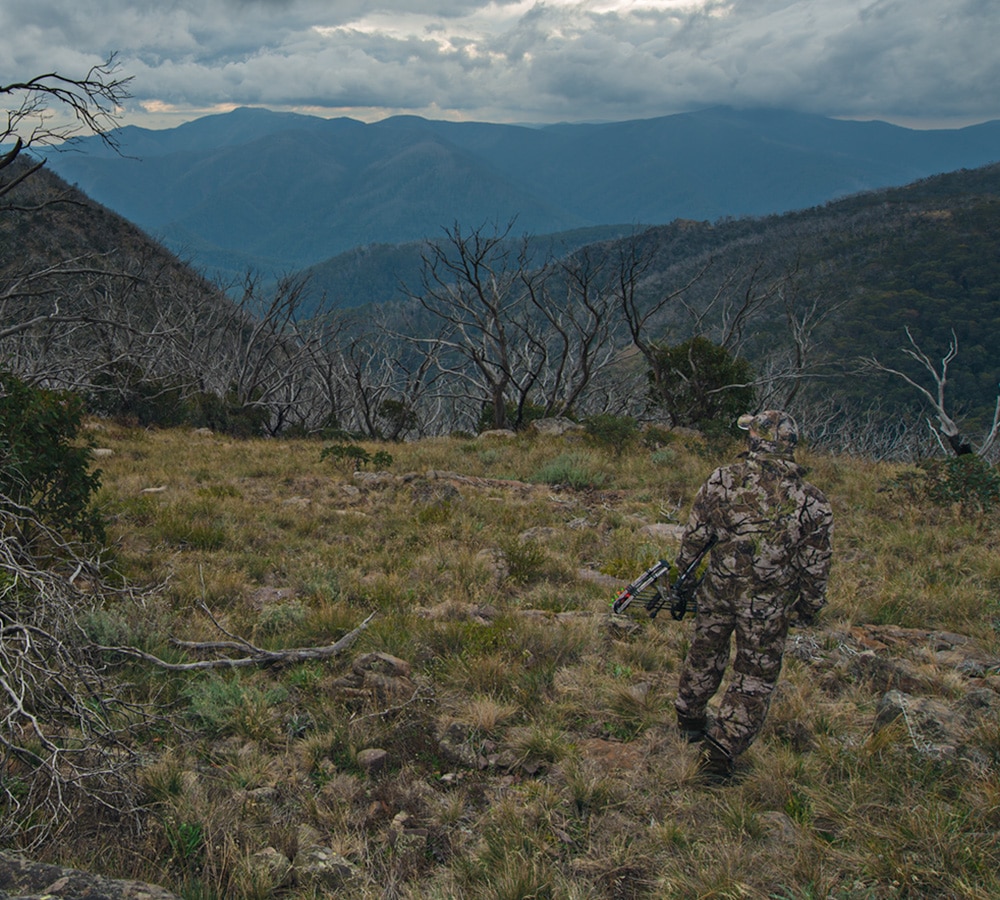
This example demonstrates a hunter crossing a mountain clearing. In this scenario the camouflage pattern is incapable to blend the hunter into his surroundings, however the isoluminance based macro pattern ensures boundary disrupting deception.
Conclusion
Evade OmniVeil has been designed and developed for the stalking hunter, a camouflage solution for the hunter who moves through his hunting environment. Pattern disruption and texture enable blending concealment for close vicinity encounters or ambush hunting situations, while macro pattern performance limits outline boundary detection to enhance visual recognition deception while stalking game. It has been created to provide camouflage throughout a wide variety of habitats, thus making its use not only versatile but also of economic benefit, and negating the need for multiple purchases of habitat specific solutions.
Question:
Do you produce gloves in TUSX pattern ?
Regards Stewart
Hi Stewart, thanks for your inquiry. We don’t have gloves right now, but we are currently working on camo hunting gloves that should be available later this year. Thanks again.
After all that effort they put on straight black zippers right out where they are easily seen
Hi Wolfbilly,
Not all of our products use black zippers, if you go through our product catalogue on this website you may notice this.
Would this work here in the states hunting from a tree stand? I live in the Midwest. Lots of pine, oaks and maple tree. Thinking it’s would be good for early season before the leaves fall.
Thanks for your inquiry. Our Evade OmniVeil camouflage pattern has demonstrated itself to be effective in many and varied environments including elevated treestand positions. We are continually expanding on our apparel line of products, currently many of our styles are lightweight and better suited to warmer conditions so yes our products should suit your early season climate. Please see an image sent to us on Facebook demonstrating our gear in real world circumstances from an elevated position.
Image courtesy – Daz
On a recent Buff hunt Tusx camo worked awesome I had a lot of close encounters with Buff, pigs and even the odd dingo and scrub bull.
Well done mate on a great adventure… 🙂
Amazing gear
Thanks George… 🙂
Due for some new gear before an upcoming qld trip but been going hard in this set for a couple of years now
Thanks for the feedback mate…
Work fine on the human eye but how effective against ungulates?
Provided you use a non UV enhancing detergent right?
Our fabrics are factory enhanced to ensure they do not emit ultraviolet light, but yes, using detergents without UV brighteners will ensure they continue to wok this way.
We spent a lot of time developing this camouflage to not only provide concealment from dichromatic (ungulates) vision, but also from tetrachromatic (bird) vision. Birds often serve as a warning species when stalking game.
Any hunter who has hunted Himalayan tahr in New Zealands Southern Alps will attest to the raucous cries of the mountain Kea potentially alerting game to a hunters presence. Likewise, when sitting on a waterhole in the Aussie outback waiting in ambush of game, many hunters are aware of the emus keen vision betraying their presence. And when and emu spooks, it will invariably warn all game in the near vicinity.
Birds with their tetrachromatic vision do see color, for this reason we have developed our camouflage to be effective with species that have color vision. This is why it also appears effective to the human eye (trichromatic vision).
There is also evidence that species with tetrachromatic vision may also see into the ultraviolet spectrum in a similar way to that of dichromatic ungulates. For this reason we always ensure our fabrics do not emit ultraviolet light. You may read more about this on the following post:
Worlds first Original BUFF® to not reflect ultraviolet light
Been using this gear for a few years! love it .. definitely the best going around !! Top blokes aswell .. hopefully bump into them at sydney show this month!
Thanks for your feedback…
Brilliant write up. Simply brilliant. Love your work
Thank you very much.
Best gear in Gippsland
Thanks mate… 🙂
Have be using the gear for a few months now and it’s definitely the best gear I’ve used from hunting chital to sambar and plenty more in between
Thanks for your feedback.
So glad you guys made it to Brisbane this year, I’ve waited ages to finally see the products and get some!!! Thanks again!
Thanks for your support.
Now that was interesting… I thoroughly enjoyed that, thanks for enlightening us, great read!
I’d been competently bewildered how one pattern could be so effective in so many different and varied terrains and settings. I won’t pretend I understood all the technical jargon but I now have a good understanding of how you were able to achieve what you have with this amazing pattern. Not without what looks like some pretty involved field testing I might add. And to compliment the pattern you’ve backed it up with high quality, technically advanced materials.
Mate, you may not have been able to develop one pattern to be completely effective in ALL terrain but you’ve come damn close. Leaps and bounds ahead of anything out there in my humble opinion. Hats off to ya, you’ve certainly produced something special here. Great product… Excited to see what lies ahead!
Thanks mate… Yes the development process was quite extensive. Creating a multi-terrain pattern is difficult due to the changing habitat variables. The pattern itself is built off core camouflage principals. Thanks for taking the time to read the article. Yes, we have more products in the pipeline… 🙂
I’m a bit arty and I find camouflage patterns really interesting. I’m always analysing what works and what doesn’t, so it’s really exciting for me to read your product description and see that Many of the conclusions you have come to in your research are the same as I have come to through my own experience. But I guess as soon as I saw the pattern I knew you were on the same page, that’s why I had to come check out your site. Best of luck with the growth of your business, I hope a bunch of other gear manufactures licence the use of your design if they haven’t already (assuming that works for you). Cheers!
Hi Chris,
Thanks for your comments. Yes our OmniVeil pattern was developed over many years using both practical field experience and core camouflage principles.
We do not licence our camo as it gives uniqueness to our brand. Thanks for your interest.
Would you think your camo pattern works in Europe as well too? Has it been tested for EU use. Our foliage and surroundings may be slightly different, greener…?
Do you have any distributors/retailers anywhere in Europe yet? I live in Belgium. Customs over here are ripping us off with mail orders, disgusting how many import taxes!
Best regards, Jef Schryvers, Belgium
Hi Jef,
Our camouflage pattern has been designed to work in multiple environments, including greener ones. It differs from almost any other pattern out there in the way it adapts its colors to its surroundings. It will often display a tendency to look more green when it is in a green environment, and more brown when in a brown environment. You may see this displayed by viewing our Instagram page, there are many, many examples there of customers wearing our apparel in various terrains, including some from Europe.
Go to – http://www.instagram.com/tusxhunter – or simply search our handle “@tusxhunter” on Instagram.
Yes we do ship our products worldwide including European destinations, however we do not currently have distribution in this region. We have heard that import taxes can be high in some European countries, and can understand how this may increase the price of international orders. We are required by law to display our product prices inclusive of sales tax, however any foreign orders will not be subject to our local taxes when placing orders on our website.
Hope this answers your questions, please let us know if you require additional clarification and thanks for your inquiry.
Does this pattern have non reflective radiance? I know some animals see in the IR range and was wondering if the Tusx range eliminates this?
Thanks
Hi Paul,
Thanks for your comment. We do test our fabrics to ensure they do not emit ultraviolet light, there is much research to demonstrate that many mammals with dichromatic vision and many birds with tetrachromatic vision can see into the ultraviolet spectrum. You can see a demonstration on the difference between fabric that does and does not emit ultraviolet light in our post on our OmniVeil BUFF® product. We were the first brand to release a genuine BUFF® to not reflect ultraviolet light:
Worlds first Original BUFF® to not reflect ultraviolet light
To get back to your original question, we are not aware of many vertebrae that can see infrared light with the possible exception of some reptiles. We have not tested our fabrics for IR light. What animals do you know of that can see infrared light?
Extremely impressed by the look at this gear,seems to blend well into any surround in human vision so is obviously hides the hunter even more in animal vision…. Has been added to wish list!! Great stuff guys!
Thank you for your comment… 🙂